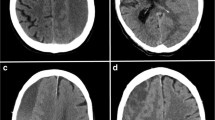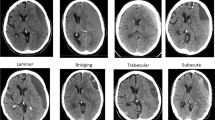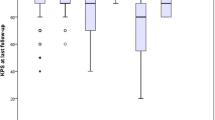Abstract
Recently, Oslo grading system (OGS) for prediction of recurrence in chronic subdural hematoma (cSDH) was introduced. The aim of the study was to validate and if applicable to modify the grading system. Data of all patients admitted to the Goethe University Hospital between 2016 and 2018 with chronic subdural hematoma were prospectively entered into a database. Dataset of patients with uni- (n = 272) and bilateral cSDH (n = 177) were used for the validation of OGS via logistic regression analysis. Additional predictors were identified and integrated to build a modified OGS (mOGS). Internal validation of the modified OGS was performed using same dataset of patients. The OGS showed a significant good predictive value with correlating increase of recurrence rate depending on the level of score in unilateral cSDH (p = 0.002). Regarding bilateral cSDH, there was no significant predictive value found (p = 0.921). By performing uni- and multivariate analysis, additional predictors for recurrence in uni- and bilateral cSDH were identified and integrated into the score system. Accordingly, the mOGS for unilateral cSDH inherited 4 components: previous OGS with 3 components (OR1.6) and seizure (OR2.5) (0 point, 0% recurrence rate; 1–2 points, 17.4%; 3–4 points, 30.6%; ≥ 5 points, 80%). Regarding bilateral cSDH, the mOGS consisted of 4 components as well: hypodense/gradation subtypes (OR3.3), postoperative unilateral volume > 80 mL (OR7.4), postoperative unilateral air trapping > 80 mL (OR15.3), and seizure (OR5.5) (0 point, 3.6% recurrence rate; 1 point, 30.6%; 2 points, 53.5%; 3 points, 58.3%; ≥ 4 points, 100%). Furthermore, the mOGS was internally verified showing high significant predictive power for recurrent hematoma in uni- (p = 0.004) and bilateral cSDH (p < 0.001). External validation of OGS showed accurate risk stratification of recurrence in unilateral cSDH; however, the validation failed for bilateral cSDH. Thus, mOGS was developed to strengthen its clinical utility and applicability.

Similar content being viewed by others
References
Brennan PM, Kolias AG, Joannides AJ et al (2017) The management and outcome for patients with chronic subdural hematoma: a prospective, multicenter, observational cohort study in the United Kingdom. J Neurosurg 127:732–731. 1–8. https://doi.org/10.3171/2016.8.JNS16134.test
Liu W, Bakker NA, Groen RJM (2014) Chronic subdural hematoma: a systematic review and meta-analysis of surgical procedures. J Neurosurg 121:665–673. https://doi.org/10.3171/2014.5.JNS132715
Stanišic M, Pripp AH (2017) A reliable grading system for prediction of chronic subdural hematoma recurrence requiring reoperation after initial burr-hole surgery. Neurosurgery 81:752–760. https://doi.org/10.1093/neuros/nyx090
Schucht P, Fischer U, Fung C, Bernasconi C, Fichtner J, Vulcu S, Schöni D, Nowacki A, Wanderer S, Eisenring C, Krähenbühl AK, Mattle HP, Arnold M, Söll N, Tochtermann L, Z’Graggen W, Jünger ST, Gralla J, Mordasini P, Dahlweid FM, Raabe A, Beck J (2019) Follow-up computed tomography after evacuation of chronic subdural hematoma. N Engl J Med 380:1186–1187. https://doi.org/10.1056/NEJMc1812507
Nakaguchi H, Tanishima T, Yoshimasu N (2001) Factors in the natural history of chronic subdural hematomas that influence their postoperative recurrence. J Neurosurg 95:256–262. https://doi.org/10.3171/jns.2001.95.2.0256
Won S-Y, Zagorcic A, Dubinski D, Quick-Weller J, Herrmann E, Seifert V, Konczalla J (2018) Excellent accuracy of ABC/2 volume formula compared to computer-assisted volumetric analysis of subdural hematomas. PLoS One 13:e0199809. https://doi.org/10.1371/journal.pone.0199809
Ko B-S, Lee J-K, Seo B-R, Moon SJ, Kim JH, Kim SH (2008) Clinical analysis of risk factors related to recurrent chronic subdural hematoma. J Korean Neurosurg Soc 43:11–15. https://doi.org/10.3340/jkns.2008.43.1.11
Kurokawa Y, Ishizaki E, Inaba K-I (2005) Bilateral chronic subdural hematoma cases showing rapid and progressive aggravation. Surg Neurol 64:444–449; discussion 449. https://doi.org/10.1016/j.surneu.2004.12.030
Mori K, Maeda M (2001) Surgical treatment of chronic subdural hematoma in 500 consecutive cases: clinical characteristics, surgical outcome, complications, and recurrence rate. Neurol Med Chir (Tokyo) 41(8):371–381
Rust T, Kiemer N, Erasmus A (2006) Chronic subdural haematomas and anticoagulation or anti-thrombotic therapy. J Clin Neurosci 13:823–827. https://doi.org/10.1016/j.jocn.2004.12.013
Torihashi K, Sadamasa N, Yoshida K, Narumi O, Chin M, Yamagata S (2008) Independent predictors for recurrence of chronic subdural hematoma: a review of 343 consecutive surgical cases. Neurosurgery 63:1125–1129; discussion 1129. https://doi.org/10.1227/01.NEU.0000335782.60059.17
Altaf I, Shams S, Vohra AH (2018) Radiolological predictors of recurrence of chronic subdural hematoma. Pakistan J Med Sci 34:194–197. https://doi.org/10.12669/pjms.341.13735
Tsai T-H, Lieu A-S, Hwang S-L, Huang TY, Hwang YF (2010) A comparative study of the patients with bilateral or unilateral chronic subdural hematoma: precipitating factors and postoperative outcomes. J Trauma 68:571–575. https://doi.org/10.1097/TA.0b013e3181a5f31c
Matsumoto K, Akagi K, Abekura M, Ryujin H, Ohkawa M, Iwasa N, Akiyama C (1999) Recurrence factors for chronic subdural hematomas after burr-hole craniostomy and closed system drainage. Neurol Res 21(3):277–280
Yamamoto H, Hirashima Y, Hamada H, Hayashi N, Origasa H, Endo S (2003) Independent predictors of recurrence of chronic subdural hematoma: results of multivariate analysis performed using a logistic regression model. J Neurosurg 98:1217–1221. https://doi.org/10.3171/jns.2003.98.6.1217
Kung W-M, Hung K-S, Chiu W-T, Tsai SH, Lin JW, Wang YC, Lin MS (2012) Quantitative assessment of impaired postevacuation brain re-expansion in bilateral chronic subdural haematoma: possible mechanism of the higher recurrence rate. Injury 43:598–602. https://doi.org/10.1016/j.injury.2010.07.240
Fujitani S, Ishikawa O, Miura K, Takeda Y, Goto H, Maeda K (2017) Factors predicting contralateral hematoma growth after unilateral drainage of bilateral chronic subdural hematoma. J Neurosurg 126:755–759. https://doi.org/10.3171/2016.1.JNS152655
Yang AI, Balser DS, Mikheev A et al (2012) Cerebral atrophy is associated with development of chronic subdural haematoma. Brain Inj 26:1731–1736. https://doi.org/10.3109/02699052.2012.698364
Stanišić M, Hald J, Rasmussen IA, Pripp AH, Ivanović J, Kolstad F, Sundseth J, Züchner M, Lindegaard KF (2013) Volume and densities of chronic subdural haematoma obtained from CT imaging as predictors of postoperative recurrence: a prospective study of 107 operated patients. Acta Neurochir 155:323–333; discussion 333. https://doi.org/10.1007/s00701-012-1565-0
Szemerey IB (2006) The fasciocapsular flap in capsular herniation. Aesthet Plast Surg 30:277–281. https://doi.org/10.1007/s00266-005-0082-4
Won S-Y, Dubinski D, Sautter L, Hattingen E, Seifert V, Rosenow F, Freiman T, Strzelczyk A, Konczalla J (2019) Seizure and status epilepticus in chronic subdural hematoma. Acta Neurol Scand 140:194–203. https://doi.org/10.1111/ane.13131
Won S-Y, Konczalla J, Dubinski D, Cattani A, Cuca C, Seifert V, Rosenow F, Strzelczyk A, Freiman TM (2017) A systematic review of epileptic seizures in adults with subdural haematomas. Seizure 45:28–35. https://doi.org/10.1016/j.seizure.2016.11.017
Edlmann E, Giorgi-Coll S, Whitfield PC, Carpenter KLH, Hutchinson PJ (2017) Pathophysiology of chronic subdural haematoma: inflammation, angiogenesis and implications for pharmacotherapy. J Neuroinflammation 14:108. https://doi.org/10.1186/s12974-017-0881-y
Ho Y-H, Lin Y-T, Wu C-WJ et al (2015) Peripheral inflammation increases seizure susceptibility via the induction of neuroinflammation and oxidative stress in the hippocampus. J Biomed Sci 22:46. https://doi.org/10.1186/s12929-015-0157-8
Turgut M, Akhaddar A (2017) Dexamethasone for chronic subdural hematoma: a systematic review and meta-analysis. Acta Neurochir 159:2289–2290. https://doi.org/10.1007/s00701-017-3341-7
Mebberson K, Colditz M, Marshman LAG et al (2019) Prospective randomized placebo-controlled double-blind clinical study of adjuvant dexamethasone with surgery for chronic subdural haematoma with post-operative subdural drainage: interim analysis. J Clin Neurosci Published Online First. https://doi.org/10.1016/j.jocn.2019.08.095
Lim DJ, Chung YG, Park YK, Song JH, Lee HK, Lee KC, Chu JW, Yang YS (1995) Relationship between tissue plasminogen activator, plasminogen activator inhibitor and CT image in chronic subdural hematoma. J Korean Med Sci 10:373–378. https://doi.org/10.3346/jkms.1995.10.5.373
Nomura S, Kashiwagi S, Fujisawa H, Ito H, Nakamura K (1994) Characterization of local hyperfibrinolysis in chronic subdural hematomas by SDS-PAGE and immunoblot. J Neurosurg 81:910–913. https://doi.org/10.3171/jns.1994.81.6.0910
Hulsbergen AFC, Yan SC, Stopa BM et al (2018) International practice variation in postoperative imaging of chronic subdural hematoma patients. J Neurosurg 131:1912–1919. 1–8. https://doi.org/10.3171/2018.8.JNS181767
Author information
Authors and Affiliations
Contributions
Sae-Yeon Won: study design, data collection, data analysis, manuscript writing
Daniel Dubinski: data collection, data analysis
Michael Eibach: data collection, data analysis
Florian Gessler: study design, critical review, study supervision
Eva Herrmann: statistical analysis
Fee Keil: data collection, critical review
Volker Seifert: study supervision, critical review
Juergen Konczalla: study design, study supervision, critical review
Bedjan Behmanesh: study design, study supervision, critical review
Corresponding author
Ethics declarations
Conflict of interest
None.
Ethical approval
This study was approved by the local ethic committee of University Frankfurt.
Informed consent
Informed consent was no required for this study.
Additional information
Publisher’s note
Springer Nature remains neutral with regard to jurisdictional claims in published maps and institutional affiliations.
Rights and permissions
About this article
Cite this article
Won, SY., Dubinski, D., Eibach, M. et al. External validation and modification of the Oslo grading system for prediction of postoperative recurrence of chronic subdural hematoma. Neurosurg Rev 44, 961–970 (2021). https://doi.org/10.1007/s10143-020-01271-w
Received:
Revised:
Accepted:
Published:
Issue Date:
DOI: https://doi.org/10.1007/s10143-020-01271-w




